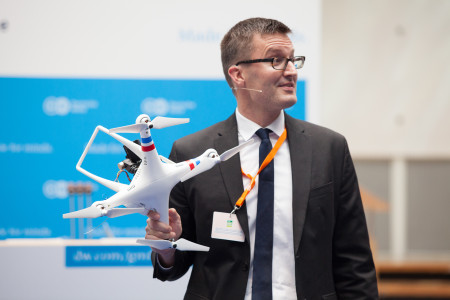By Sheikh Saaliq
Photos by Alison Klein
Many believe drone journalism is the future for news as it captures video footage from interesting perspectives. Irrespective of the huge hype around it, the question of using drones in daily journalism is still an enigma.
Mathew Waite, professor of Drone Journalism at the University of Nebraska Lincoln in the USA, has long been exploring the possibility of using drone footage in the news. Three and a half years ago, he got a $50,000 grant from the Knight Foundation to start a drone reporting program.
“The potential applications for the use of drones in journalism are varied [in covering] agriculture, media, public infrastructure, natural disasters. Like with new technologies, drones can play a vital role in modern day news coverage,” Waite says.
Waite believes that 21st-century news reporting is evolving and adding tools and techniques helps in different ways.
“Drones can be very effective and useful for covering stories with large spatial applications, particularly natural or man-made disasters. The damage of these disasters can become clear from 50 or 100 feet up in the air. Drone images can help create maps of disaster areas. Combined with data, it can explain the news in a new way,” Waite says.
Drones are useful tools but fundamentally, they are not storytelling techniques.
Waite also believes that the use of drones in journalism is “not that safe” right now. “The blades rotate very fast and can do physical damage if it falls on a person,” he says.
Another disturbing thing about the trend is cramming a drone shot into just about everything. “That might hamper the moral code of ethics of a journalist,” Waite adds.
The expert fears that news directors or producers will attempt to inject footage captured by drones at every turn. Imagine a crime scene and a mother has lost her children. Nobody would want 10 to 15 drones hovering above her head and filming her. “We need to find a solution on how to cover situations of grief and despair with drones,” Waite says.
Property laws can be a hindrance for drone journalism and so news organizations must consider whether it’s ethical to use drones to record events happening on private property.
However, Waite has already figured out the best use of drones in journalism. “I think the real future of drones in journalism is in virtual reality. You can use a drone to map a newsworthy area in a short period of time and you can use the drone to create 3D models of a place for virtual reality environments.”












